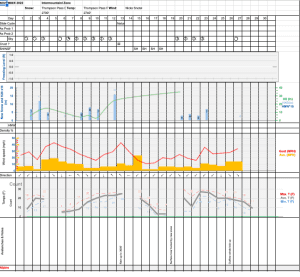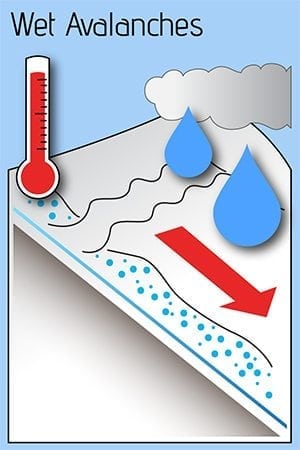Valdez
Above 4,000ftConsiderable
2,000 to 4,000ftConsiderable
Below 2,000ftModerate
Degrees of Avalanche Danger
Avalanche Problems
Problem 1
North winds will increase through the day today, becoming strong with gust up to 50 mph expected along high elevation ridge lines. There is currently a lot of loose snow available for transport. This will quickly be forming fresh wind slabs and adding to the depth of slabs created on 3/24. Wind slabs that form today are expected to be reactive to human triggers 1-2 feet in depth.
On 3/24 south winds were moderate to strong in exposed terrain. Wind slabs were building quickly with signs of instability such as shooting cracks present. Expect to find wind slabs on a variety of aspects today as winds switch to the north and increase in strength.
Wind slabs will have the potential to step down to deeper layers in the snowpack and create large, destructive avalanches (see problem 2)
Likelihood:
- Almost Certain
- Very Likely
- Likely
- Possible
- Unlikely
Size:
- Historic
- Very Large
- Large
- Small
Trend
- Increasing
- Steady
- Decreasing
Problem 2
Wind slabs that build today will be adding stress to the 2-3 feet of snow delivered by the Hamilton storm (3/17). Wind slabs may be able to step down to some of these deeper layers. Strong wind affected snow still exists at the 3/17 interface, although has been observed to be breaking down at mid elevation in some locations. This will increase the potential for a person or machines weight to stress deeper layers in our snowpack.
In areas that were more protected from late February-early March north winds, the 3/17 interface consists of near surface facets. This difference in interface is important to identify.
Human triggered avalanches are possible up to 4 feet deep in areas where facets are present at the 3/17 interface or where the Hamilton slab is deeper than 3 feet. These conditions are not as likely to be found within our forecast zone but have been reported in areas to the southeast of Thompson Pass that received higher storm totals, and in more continental locations where the underlying snowpack is weaker. Use caution in steep terrain that is being actively loaded by wind.
Ski pole probing and digging snowpits are good ways to identify what type of interface the recent new snow is sitting on. The 3/17 interface continues to be a low friction potential bed surface. There is uncertainty if this will become an issue as we receive more snowfall and/or heat is able to heat penetrates further into the snowpack in the future.
Other persistent weak layers exist in our mid to lower snowpack. These are currently unlikely to be affected where very strong wind affected snow exists at the 3/17 interface.
Likelihood:
- Almost Certain
- Very Likely
- Likely
- Possible
- Unlikely
Size:
- Historic
- Very Large
- Large
- Small
Trend
- Increasing
- Steady
- Decreasing
Problem 3
Wet loose avalanche activity is expected to be limited today as strong winds will likely keep slopes cold. The one exception may be on low elevation south aspects of the Maritime zone. Wet loose avalanches that may occur today are expected to be small in size. Avoid steep terrain where the surface snow is becoming moist to wet during the heat of the day
Likelihood:
- Almost Certain
- Very Likely
- Likely
- Possible
- Unlikely
Size:
- Historic
- Very Large
- Large
- Small
Trend
- Increasing
- Steady
- Decreasing
Problem 4
Weak snow exists at the base of our snowpack. This weak snow is currently unlikely to be affected due to the strength of old wind affected snow at the 3/17 new/old interface. Depth hoar may become a concern later in the season if our area continues to see major snowfall and the very strong wind damaged layer at the new/old interface starts to break down and lose strength within the snowpack. As very hard wind slabs break down within the snowpack a person or machines weight will have a more direct affect on weak layers at the bottom of the snowpack. In addition, the increasing intensity of the sun will be putting pressure on deep layers during the heat of the day.
Likelihood:
- Almost Certain
- Very Likely
- Likely
- Possible
- Unlikely
Size:
- Historic
- Very Large
- Large
- Small
Trend
- Increasing
- Steady
- Decreasing
Avalanche Activity
Below is a summary of observed Avalanche activity from the last 7 days. Avalanches that were noted earlier in the season can be viewed by clicking the link below.
If you trigger or observe an avalanche consider leaving a public observation.
3/24- Ski cuts were reported as being productive, with avalanches up to D2 at the 3/21 interface.
3/18-21- Several D1-D2 human triggered avalanches have been reported. For the most part these have been outside our forecast zone and appear to be more likely in areas with either a weaker underlying snowpack (continental zone) or where storm totals were higher (SE of Thompson Pass). Remote triggers have also been reported as the Hamilton storm slab has settled and gained cohesion.
3/17- Multiple D1-D2 natural storm slab avalanches were reported and observed along the road corridor. These all failed within the storm snow with the exception of one deep persistent avalanche reported on Billy Mitchell.
Weather
Check out our updated weather tab! A collection of local weather stations are available for viewing with graphs and tabular data included.
NWS Watches, warnings and advisories
NONE
NWS Point forecast for Thompson Pass
Date Friday 03/24/23 Saturday 03/25/23 Time (LT) 04 10 16 22 04 10 16 22 04 Cloud Cover SC BK OV OV BK FW FW FW SC Cloud Cover (%) 35 55 80 85 65 10 10 20 45 Temperature 15 18 25 21 13 9 19 12 9 Max/Min Temp 26 9 19 8 Wind Dir W S SW S N N N NE NE Wind (mph) 4 3 13 14 23 34 31 25 16 Wind Gust (mph) 51 Precip Prob (%) 5 5 30 50 10 0 0 0 0 Precip Type S S S 12 Hour QPF 0.00 0.10 0.00 0.00 12 Hour Snow 0.0 0.2 0.0 0.0 Snow Level (kft) 0.0 0.0 0.1 0.0 0.0 0.0 0.0 0.0 0.0
Click on link below for Thompson Pass weather history graph:

| Date:
03/25 |
24 hr snow | HN24W* | High temp | Low temp | 72 hour SWE* | March snowfall | Seasonal snowfall | Snowpack Depth |
| Valdez | 0 | 0 | 40 | 26 | N/O | 17 | 235 | 54 |
| Thompson Pass | N/O | 0 | 24 | 17 | N/O | 58 | 426 | N/O |
| 46 mile | Trace | 0 | 38 | 1 | N/O | 33 | ~115** | ~60 |
*HN24W- 24 hour Snow water equivalent in inches
*SWE– Snow water equivalent
**46 mile seasonal snowfall total begins December 1st.
Additional Information
Click on the link below for a running summary of the seasons weather history.
Announcements
The avalanche hazard is Considerable above 2000′ and moderate below. Strong winds today will be forming fresh wind slabs. Human triggered avalanches 1-2 feet deep are likely in recently wind loaded terrain that is steeper than 35°. Natural avalanches are possible. Avoid steep terrain being actively loaded by wind and watch for signs of instability such as shooting cracks, collapsing or recent avalanche activity.
Posted by Gareth Brown 03/25 7:30 am.
For a description of current avalanche problems, weather information, season history and more click the (+ full forecast) button. Avalanche forecasts will be issued Wednesday-Sunday.
If you have pictures of recent natural or human triggered avalanches or notice signs of instability such as shooting cracks or collapsing, leave an observation to help improve forecast accuracy.



